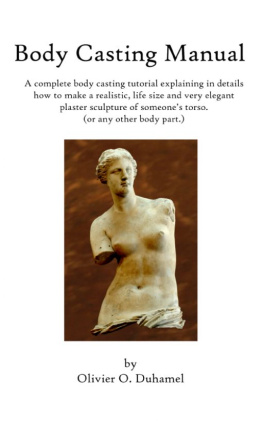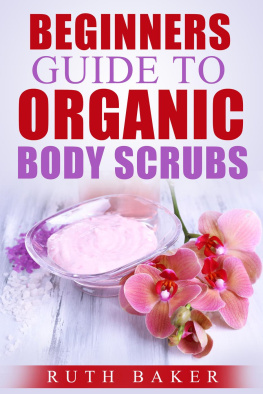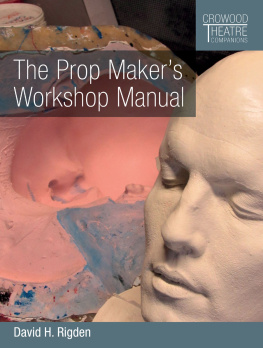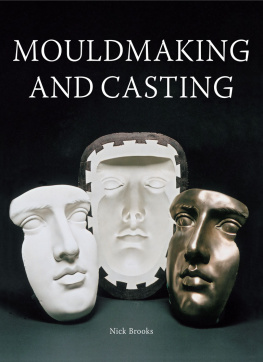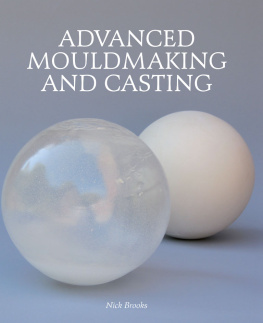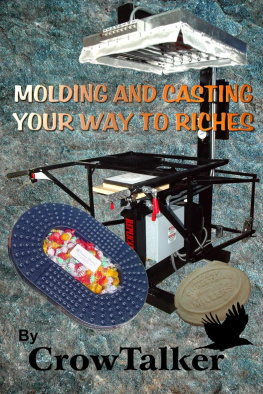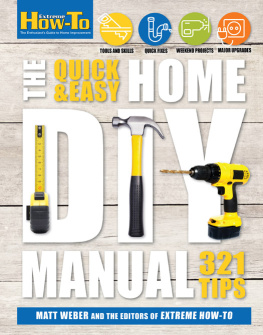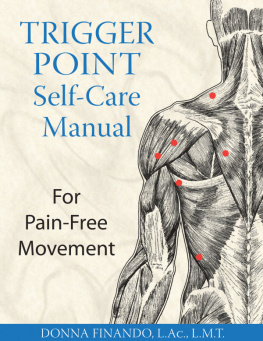Body Casting Manual
A complete body casting instruction manual explainingin details how to make a realistic, life size and very elegantplaster sculpture of someones torso (or any other body part)
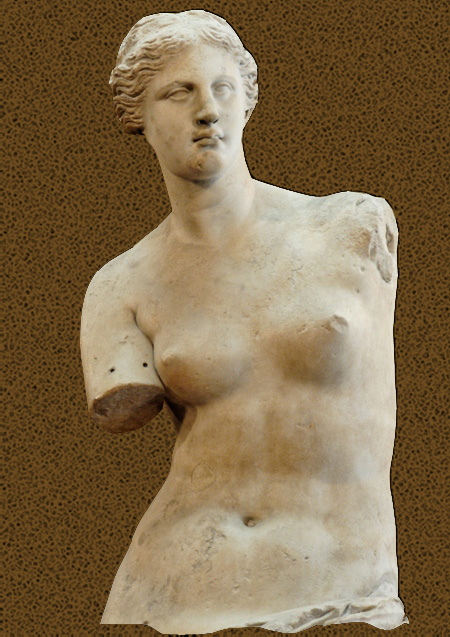
Body Casting Manual
Olivier Duhamel
Smashwords Edition
Copyright 2009-2011 Olivier Duhamel
This book is available in print at most onlineretailers
Smashwords Edition, License Notes
This ebook is licensed for your personal enjoymentonly. This ebook may not be re-sold or given away to other people.If you would like to share this book with another person, pleasepurchase an additional copy for each recipient. If youre readingthis book and did not purchase it, or it was not purchased for youruse only, then please return to Smashwords.com and purchase yourown copy. Thank you for respecting the hard work of thisauthor.
Limitations of liability
Bodyscape Waiheke Island Sculpture Studio assumes noresponsibility and will not be liable for any damages to persons orproperties caused by or arising from your access to this tutorial.We assume no responsibility and will not be liable for any accidentor injuries caused by or arising from your utilization of thetechniques described in this manual.
Table of content
Written by Waiheke Island sculptor and life caster OlivierDuhamel, this life casting guide documents in detail all the steps necessary to makea mold and plaster casting of someones chest.
The resulting sculpture will be an amazinglydetailed reproduction of someones body, a durable, faithful andelegant memento.
This is an easy, safe, fun and inexpensiveproject. These simple, detailed and complete instructions andillustrations will ensure that your project is a success.
Although this guide uses a womans bust as anexample, the same techniques can be applied to cast any other bodypart.
The second part of the manual discusses somemore advanced techniques and methods and explains how to approachsome other casting projects such as pregnant belly, face, hands andfeet.
All measurements are expressed in bothmetric and US customar yunits.
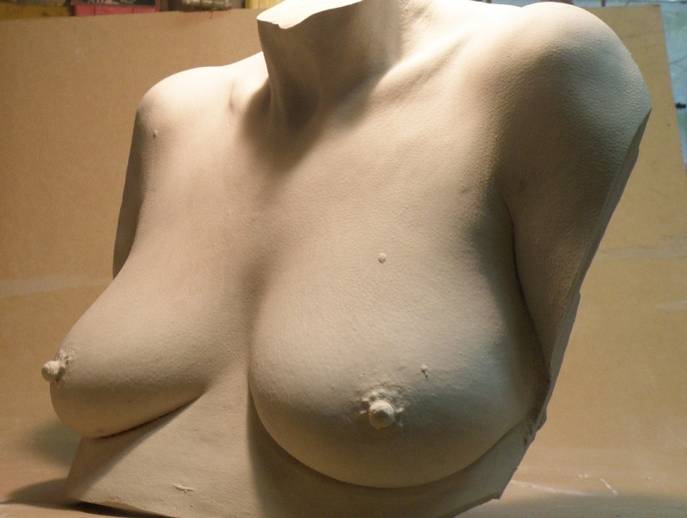
Before delving into the heart of thematter, I thought that I would write a bit more about life castingand body casting in general. You can choose to skip this sectionbut make sure to read everything else
What is life casting?
Life casting, also called body casting is theart of making a mold of a live model to make a life size, life likethree dimensional reproduction of someones body or part of thebody.
A bit of history
The ancient Egyptians are the first recordedlife casting craftsmen. Indeed some of their works survivedcenturies and can be admired in museums around the world. However,more modern techniques and materials have allowed life castingartists to make much more realistic pieces. This guide will showyou how to achieve the most incredibly detailed reproduction atvery little costs.
Famous body casters
Body casting has long been dismissed a justbody casting on the pretence that it was simply copying lifeinstead of interpreting it though the artists hands. The veryrespectable Auguste Rodin was once accused of having cast one ofhis sculptures. The master was greatly offended by theseaccusations.
In more recent times, artists such asGeorge Segal, John deAndrea and Duane Hanson have done work of suchexcellence that they have given to the medium its letters ofnobility.
This is the list of tools and materials you will need tocomplete the project. It should all cost no more than a restaurantmeal for two and a bottle of wine.
One plastic bucket
One bag of 1 kg of Alginate (35 oz or 2 lbs)
5 rolls of plaster bandage (10 cm * 3.5 m) (4 in * 4 yd)
A few pairs of latex gloves
10 kg of Plaster of Paris (20 lbs)
2 or 3 empty soft drink bottles
A plastic bowl
A power drill and a paint mixer attachment
One chip brush of medium size
Scissors
Cotton balls
A kitchen scale
A clean towel
Alginate is a natural compound made fromseaweed. It is sold as a fine powder which when mixed with watermakes a paste that will set and harden in a few minutes. Dentiststraditionally use alginate to take tooth impression. It is organicand skin safe.
Which alginate to buy?
I am using an alginate called Aroma fine DFIII made by GC Corporation of Japan.
Dentists want their alginate to set asfast as possible for the comfort of their patient. The body casterwants an alginate that sets more slowly. (3 to 5 minutes at roomtemperature). Do not buy anything advertised as fast setting.Other than that, most alginate will work for yourpurpose.
Which plaster gauze to buy?
Plaster gauze is what doctors use to cast abroken limb. My preferred plaster gauze is Gypsona 10 cm wide by3.5metres long. (4 in * 4 yd) but anything else will work just aswell.
Where to buy?
To find suppliers in your area, search forthe name of your nearest city and the following keywords: dentalsupplies, alginate, medical supplies, plaster gauze, mold (ormould) making supplies. To make it quick and easy to find asupplier in your ar ea,we have listed a selection of online shops in the appendix at theback of the manual.
Plaster of Paris, plastic buckets, chipbrushes and latex gloves can be purchased from most hardwarestores. You will only need 6 to 7 Kg. of plaster (12 lbs) but itgenerally comes in larger bags. You want standard Plaster of Paris.Do not buy any kind of fast setting plaster.
Additionalmaterials
You may also need thefollowing:
A large sheet of plastic to cover and protect the floor of yourwork area
A pile of old clothes
An arms length of strong electric cable or chai
A small pot of plaster filler
A small bag of white shellac
A sponge
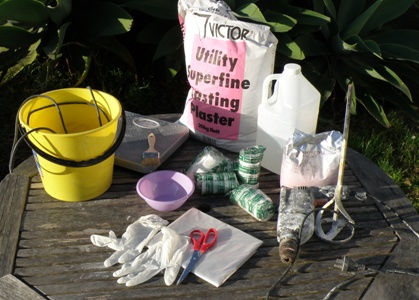
Thisis about all the materials you will need .
Thissection describes the body casting process in broad lines. There are two major steps inthe process. The first step consists of making a mold of the livemodel. The second step consists of casting plaster into thatmold.
This is not unlike photography where youfirst record an image and then print it on paper.
The mold is made of two separate layers. Afirst layer, which I call the alginate skin, captures the skintexture but is too flexible to remember the pose and too fragile toreceive liquid plaster. A second layer of plaster bandages must beapplied over the alginate to set its position and give the moldenough strength to receive the liquid plaster. This second layer iscalled the plaster shell or mother mold.
You will apply a layer of alginate directlyon your models skin. You will then cover this alginate skin withseveral layers of plaster bandages to encase the alginate skin in aplaster shell. These are the same kind of bandages that a doctorwould use to cast a broken arm. When the plaster bandages have set,the entire mold is removed from the model and set on the floor,open side up. The whole operation takes no more than half anhour.
A batch of liquid plaster is then mixedand painted or poured inside the alginate mold. After a few hours,the plaster has set and the alginate and bandage mold can beremoved to reveal a solid plaster replicate of your models body.The first part of this manual describes in more detail this simpleprocedure

